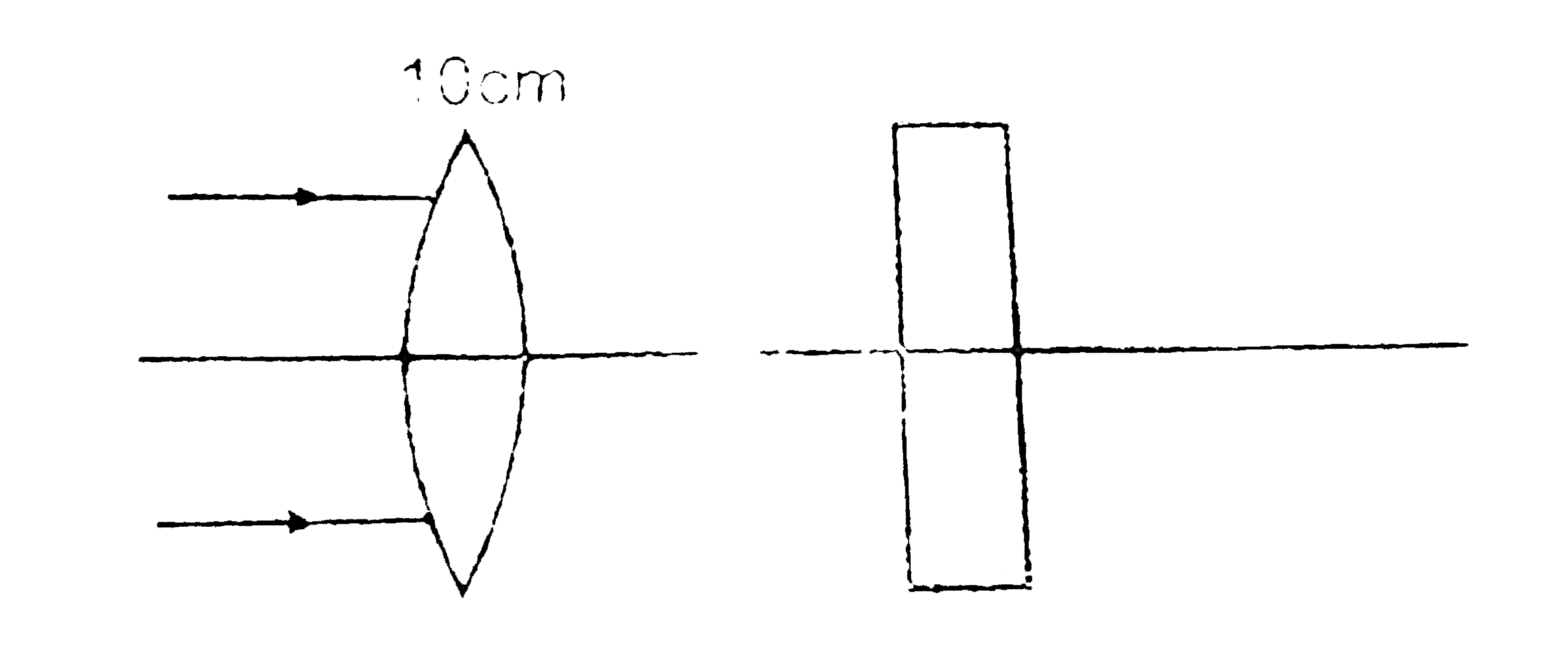A long cylindrical tube containing water in closed by an equinvex lens of local length 10 cm in air. A point source is placed along the axis of the tube outside it at a distance of 21 cm from the lens. Locate the final image of the source. Refractive index of the materials of the lens =1.5andtˆofwater=1.33.Solution in Gujrati
 <br> The light from the source S gets refracted at the air glass interfasce and then at the glass water interface. Referring to the ure,let us take vertically downward as the positive direction of the axis. <br> If the image due to the refraction at the first surface is formed at a distance <span class=) v1 from the surface, we have
v1 from the surface, we have
1.5v1−1u=1.5−1R.....i
where R is the radius of curvature of the surface. As the lens is equiconvex, the radius of curvature of the second surface is -R. Also teh image formed by the first surface acts as the object for the second surface. Thus,
1.33v−1.5v1=1.33−1.5−R....ii
Adding i and ii
1.33v−1u=1R(0.5+0.17)=0.67R
or43v+121cm=23R
or1v=12R−128cm...........iii
The focal lenth of the lens in air in 10 cm. Using
1f=(μ−1)(1R1−1R2)
=110cm=(1.5−1)(1R+1R)
or R=10cm<br>Thusbyiii<br>1/v=1/(20cm)-1/(28cm)
or v=70cm
The image is formed 70 cm inside the tube.
Topper's Solved these Questions
- GEOMETRICAL OPTICSBOOK - HC VERMACHAPTER - GEOMETRICAL OPTICSEXERCISE - Short Answer
18 Videos
- GEOMETRICAL OPTICSBOOK - HC VERMACHAPTER - GEOMETRICAL OPTICSEXERCISE - Question For short Answer
1 Videos
- GEOMETRICAL OPTICSBOOK - HC VERMACHAPTER - GEOMETRICAL OPTICSEXERCISE - EXAMPLE
3 Videos
- GAUSS LAWBOOK - HC VERMACHAPTER - GAUSS LAWEXERCISE - Exercises
24 Videos
- LIGHT WAVESBOOK - HC VERMACHAPTER - LIGHT WAVESEXERCISE - Exercises
41 Videos
Similar Questions
Is the formula "Real depth/Apparent depth =μ. valid if viewed from a position quite away from the normal ?
View SolutionTwo converging lenses of unequal focal lengths can be used to reduce the aperture of a parallel beam of light without loosing the energy of the light. This increases the intensity. Describe how the converging lenses should be placed to do this.
View SolutionA convex mirror has its radius of curvature k=20 cm. Find the position of the image of an object placed at a distance of 12 cm from the mirror.

View SolutionThe electric field in a region is given by →E=35E0→i+45E0→j with E0=2.0×103NC−1. Find the flux of this field through a recatngular surface of area 0.2m2 parallel to the y-z plane.
View SolutionFind the range of frequency of light that is visible to an average human being (400nm<λ<700nm)
View SolutionA long cylindrical tube containing water in closed by an equinvex lens of local length 10 cm in air. A point source is placed along the axis of the tube outside it at a distance of 21 cm from the lens. Locate the final image of the source. Refractive index of the materials of the lens =1.5andtˆofwater=1.33.
View SolutionThe radii of curvature of a lens are + 20 cm and + 30 cm. The material of the lens has a refracting index 1-6. Find the focal length of the lens (a) if it is placed in air, and (b) if it is placed in water (mu = 1.33).
View SolutionA parallel beam of light is incident on a lens of focal length 10 cm. A parallel slab of refractive index 1.5 and thickness 3 cm is placed on the other side of the lens. Find the distance of the final image from the lens.
 .
.
View SolutionAn object of size 2cm is placed at a distance of 40cm from a glass lens, close to the principal axis of the lens, and the lens forms an image of size 2cm . What is the size of the image and what type of image is formed if the lens and the object, in the same arrangement, is immersed into water ? The refractive index of the lens 1.5 , and that of the water is 1.33 .
View SolutionA lens behaves as a converging lens in air and a diverging lens in water. The refractive index of the material is (refractive index of water =1.33)
View SolutionA biconcave lens made of a transparent material of refractive index 1.5 is immersed in water of refractive index 1.33. Will the lens behave as a converging or a diverging lens? Give reason.
View Solutionएक उत्तल लेंस (μ=1.5) की फोकस दूरी 0.3 मीटर है। यदि इस लेंस को पानी में डुबा दिया जाये तो इसकी फोकस दूरी कितनी होगी। पानी का अपवर्तनांक 1.33 है।
View Solution1.50 अपवर्तनांक वाले काँच के एक लेंस की वायु में फोकस दुरी 0.3 cm है। यदि 1.33 अपवर्तनांक के जल में डुबोया जाये तो लेंस की फोकस दुरी ज्ञात कीजिये।
View Solutionएक उत्तल लेन्स की वायु में फ़ोकस दूरी 20 cm है | जल में फ़ोकस दूरी कितनी होगी ? (वायु-जल के लिए अपवर्तनांक = 1.33, वायु-काँच का अपवर्तनांक = 1.5)
View SolutionA lens behaves as a converging lens in air and as a diverging lens in water. If refractive index of water is 1.33 , the refractive index of the material of the lens will be
View SolutionA long cylindrical tube containing water in closed by an equinvex lens of focal length 10 cm in air. A point source is placed along the axis of the tube outside it at a distance of 21 cm from the lens. Locate the final image of the source. Refractive index of the materials of the lens =1.5 and that of water =1.33.
View Solution
